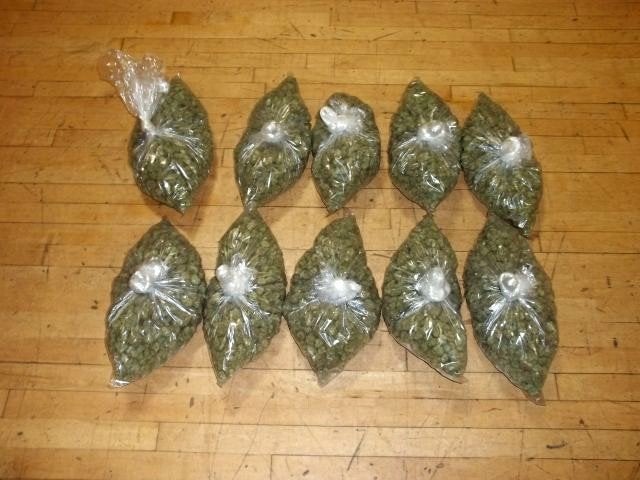
WASHINGTON -- A leading distributor of crack cocaine in the 1980s would have preferred to have been a pot dealer, but was unable to find enough supply, he told The Huffington Post in an interview.
"I wanted to sell pot. You couldn't get pot at a decent price -- I couldn't, nor the quantity," said Rick Ross, whose operation the Los Angeles Times dubbed "the Wal-Mart of crack dealing." Ross built one of the largest cocaine empires in the country, expanding his operation to at least a dozen major cities.
"I could get a pound here, a pound here, once in awhile a few additional pounds, but I couldn't get a constant, steady, good-price pot [connection]. You just couldn't get it in the early '80s, when I was selling coke," he said. Prosecutors estimated Ross made some $600 million over the course of his career. The rapper Rick Ross took his name from the crack dealer.
(The real Rick Ross added, however, that he was not currently advocating using or selling either drug, but merely reflecting on his motivations at the time.)
A confessed inability to find a steady supply of marijuana might sound strange coming from a drug kingpin, but it dovetails with a broader trend at the time. For the book "This Is Your Country On Drugs," I looked at pricing data from the late '70s and '80s and found a remarkable divergence: As the price of pot skyrocketed, the price of cocaine plummeted.
Ross was locked in prison at the time of the book's writing. (His primary source of cocaine was Oscar Danilo Blandon, who was affiliated with the CIA-backed Contras, a part of this story that is too complicated to get into in this article, but is delved into in the book.)
"What I learned about weed is that weed is a more profitable business than cocaine. More people use it. You get it cheaper per pound. And it carries less amount of time," Ross said. "We just couldn't buy it. It wasn't price, because I had the money to buy whatever I wanted. So it wasn't the price. It wasn't available. It was a market I was shut out of."
It wasn't an accident.
The Drug Enforcement Administration's stated drug policy goal is to reduce supply so that price rises, which in theory will depress demand. But what happens in reality is that demand to get high simply goes elsewhere.
The movement in price was a direct result of policy put into place by President Jimmy Carter, then massively expanded by his successor, President Ronald Reagan.
Carter expanded a joint Mexican-American venture called Operation Condor, aimed at eradicating Mexican pot that had been supplied since 1975. American planes sprayed tons of herbicide on Mexican crops to kill pot plants. General José Hernández Toledo, fresh from the 1968 student massacres in Mexico City, led 10,000 soldiers into the hills of Sinaloa, Durango and Chihuahua. "Tons of drugs were destroyed, production was reduced, prices rose, but drugs continued to flow into the American market, although in lesser quantity of Mexican origin," writes sociologist Luís Astorga in the paper "Drug Trafficking in Mexico: A First General Assessment."
The action had several consequences. One, a rise in the price of pot in the United States, was intended. Others weren't. The growth of domestic marijuana farming might have eased pot shortages slightly during the '70s, but the industry was hardly the high-tech, high-efficiency bud-producing machine it is today. The encouragement of a shift from pot to cocaine importation among drug smugglers was a much more significant development in the short term. Coke, more valuable by weight and with a less detectable odor, was more profitable and much easier to move.
"Without question, in the mid- to late-'70s, there were frequently months where even working at NORML we would have a drought," Keith Stroup, the head of the National Organization for the Reform of Marijuana Laws, told HuffPost. "But there was never a shortage of cocaine, because it didn't have anything to do with a growing season ... Sometimes I'd go [to my dealer], and he didn't have any marijuana, but he always had cocaine."
Reagan redoubled efforts at curbing imports, further militarized drug policy and brought about mandatory-minimum sentences for minor drug offenses. In 1980, the FBI's Uniform Crime Report lists fewer than 100,000 arrests for heroin and cocaine, which are tabulated together. By 1989, that figure had jumped to more than 700,000.
But the first battle Reagan would fight in his war was against marijuana, which required laying siege to the once-ignored base of liberal resistance, Northern California. His Campaign Against Marijuana Production began in the harvest season of 1983. U-2 spy planes and military helicopters flew over the Golden State looking for green crops. (By the fall, corn, wheat, soybeans and the like have turned brown, making cannabis easy to spot from the sky.) The DEA reported seizing 64,579 plants at an estimated value of $130 million. Federal-law-enforcement figures marched in the streets chanting, "War on Drugs! War on Drugs!" The opposition printed bumper stickers demanding, "U.S. Out of Humbolt County."
The 1984 haul was three times larger. Nationally, pot-plant seizures rose from about 2.5 million in 1982 to more than 7 million in 1987. Reagan even began to go after "ditchweed," a wild variety of hemp that has no potential to get a user high. The first year that the White House kept data for ditchweed eradication, it claimed to have uprooted about nine million plants. That number was up to more than 120 million by 1989 and reached half a billion in 2001.
Unsurprisingly, such sustained effort drove up the price of marijuana. The DEA closely tracks drug prices and purity, although it doesn't often make the data available publicly. It did so most recently in 2004, and the numbers include a startling, if misunderstood, observation. "The marijuana price trends ... are not highly correlated with trends in prices of other drugs over time," the report reads. "While the price of powder, heroin, and, to a lesser extent, crack were falling during the 1980s, the average price of marijuana generally rose." An eighth of an ounce of pot in 1981 was going for $25. It stayed roughly the same in 1982. By 1986, it was up to $53, and it hit a high of $62 in 1991, a 150 percent rise over 10 years. Coke, meanwhile, become much more affordable. It cost nearly $600 a gram in 1982. As Reagan directed resources toward the pot battle, coke's price began to tumble. By 1989, it was down to $200 a gram, cheaper in real terms than it had been during the last national coke binge a century earlier. At the same time, average purity nearly doubled.
Clearly, the price trends are highly correlated, but the correlation is a negative one: In the '80s, price increases in marijuana drove demand toward other drugs. The war on drugs hard, soft, or otherwise helped persuade pot smokers to put down the bong and pick up the pipe, the mirror, or the needle.
Pot smoking plummeted under Reagan. About half of 12th graders in 1979 told the University of Michigan researchers they had smoked pot that year, the same as five years before. The numbers fell through the '80s, and dwindled to a fifth of 12th graders in 1992. The use of other drugs either stayed the same or increased as people started looking for a different cheap high. Reported use of inhalants nearly doubled, from 4 to 7 percent between 1981 and 1987. Cocaine, heroin, and meth use also rose in the '80s.
Heroin dropped in price by a third between 1981 and 1988. By 1996, it had dropped by two-thirds. The price of crack was falling as well. The DEA started tracking it only in 1986, around the time the drug's use became widespread. Its price fell by about half over the next five years. In rural areas, the price of meth fell by a quarter from the early '80s to the middle of the decade. If the goal of U.S. drug policy is to lower demand by increasing price, Reagan's drug war did precisely the opposite, driving people away from pot and toward coke and crack.
"Cocaine was readily available," said Ross. "People are attracted to the thing that makes the most money, the most profit. But I guess making cocaine more readily available put it in position to outdo the marijuana, because you can't get the marijuana, so you get high on what you can get."
CORRECTION: An earlier version of this story said that, according to Ross, he and Jamie Foxx were working on a feature film together. Foxx's representative later denied the claim.
